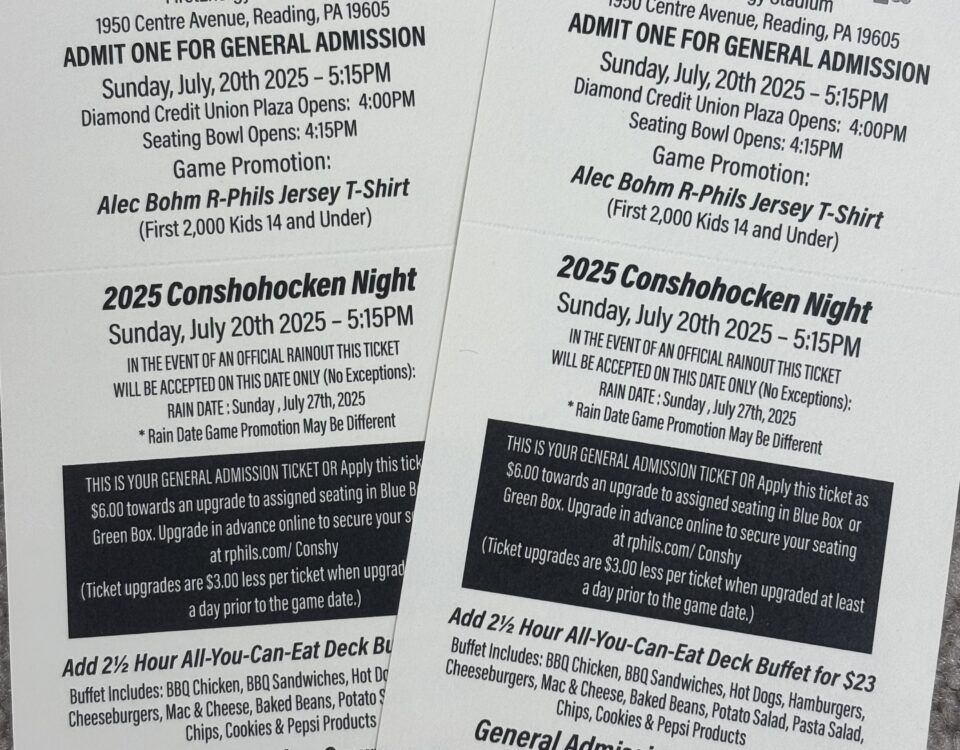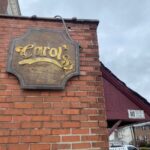
Carol’s
February 15, 2024
6 Degrees of Kevin Bacon and the Conshohocken Connection
February 27, 2024Talkin’ Music – Black History Month. Searching for Kentucky Avenue Atlantic City
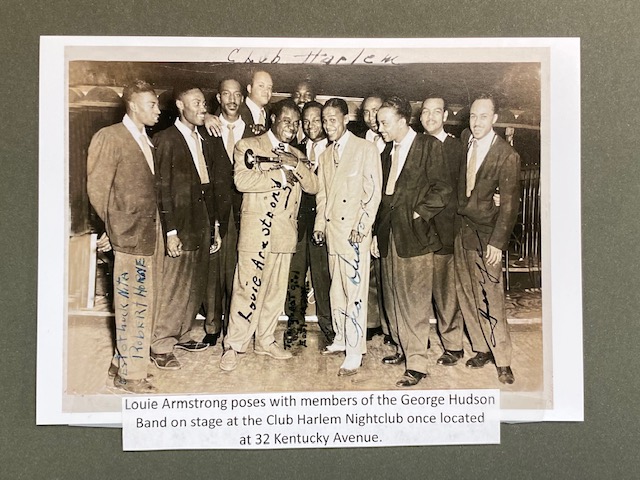
Talkin’ Music
Black History Month
Searching For Kentucky Avenue
The Real Class of Atlantic City
By Jack Coll
2-10-24
Atlantic City, New Jersey, for many years was tagged as “America’s Playground” and who could argue with that. I mean after-all they had an ocean, a beautiful beach, world class hotels and restaurants, Atlantic City had a boardwalk that stretched as far as the eye could see, and when it came to the entertainment aspect, well they had “Steel Pier.”
Steel Pier was a 1,000 foot long amusement park when it opened on June 18, 1898 and became known as one of the most popular venues in the United States for the first seven decades of the twentieth century. The pier featured concerts, exhibits and amusement rides. It billed itself as the “Showcase of the Nation.”
From 1935 until 1938 the Steel Pier was where Miss America was crowned, the pier later hosted “The Diving Horse,” “Rex the Wonder Dog,” “The Human Cannon Ball,” and a water skiing K-9, along with singing and dancing stars.
The pier was sold a number of times over the years and became known as the “Million Dollar Pier,” and later added dance bands, three movie theatres, exhibits, opera’s, children shows, a water circus, stunts and other attractions.
Atlantic City’s Boardwalk had it all, the beach, the hotels, the boardwalk and Steel Pier, but they didn’t have Kentucky Avenue. Now, some years ago I heard about Kentucky Avenue and the club scene along the strip. I heard about all the black entertainers that would show-up along Kentucky Avenue to perform nightly. I was also told about the crowds both black and white that would line up around the block hoping to get into one of several clubs.

Now I consider myself a huge music fan, with a lot of knowledge of performers, and bands of every kind. I spent nearly thirty years at the Philadelphia Folk Festival, meeting, greeting and interviewing the performers along with attending hundreds of other concerts seeing everyone from Bob Dylan, to the Rolling Stones, to James Brown. I’ve visited more than a dozen recording studio’s over the years in all parts of the country including Sun Recording Studio in Memphis, Tennessee, Hitsville USA, otherwise known as the Motown Recording Studio in Detroit, Stax Recording Studio also in Memphis Tennessee, Muscle Shoals Sound Studio, FAME Recording Studio and Cypress Moon Recording Studio all in Sheffield, Alabama and RCA Studios in Nashville Tennessee along with many other studio’s.
I’ve taken my wife Donna all over the country visiting sites of past and present music icons locations like Patsy Cline’s childhood home in Winchester, Virginia, I’ve stood at the graveside of Buddy Holly in Lubbock Texas, went to Port Arthur, Texas to visit the Janis Joplin Museum, and went in search of Butcher Holler, deep into the hills of Eastern Kentucky just to view Loretta Lynn’s childhood cabin.
I spent hours at the “Rock and Roll Landmark” the Surf Ballroom in Clearlake, Iowa, looking for the ghost of Ritchie Valens, J. P. “Big” Bopper and Buddy Holly, the location best known as “The Day The Music Died,” and I spent an afternoon walking the grounds of the 1969 Woodstock Festival. I’m a self-taught musician who can read music and played guitar in a number of different versions of garage bands back in the day.
I would like to think I know a lot about music and a little bit about the country’s hot-spots in the music industry, but I never heard about Kentucky Avenue in Atlantic City. So, a couple of years ago I set out to learn more about Kentucky Avenue and the so-called club scene.
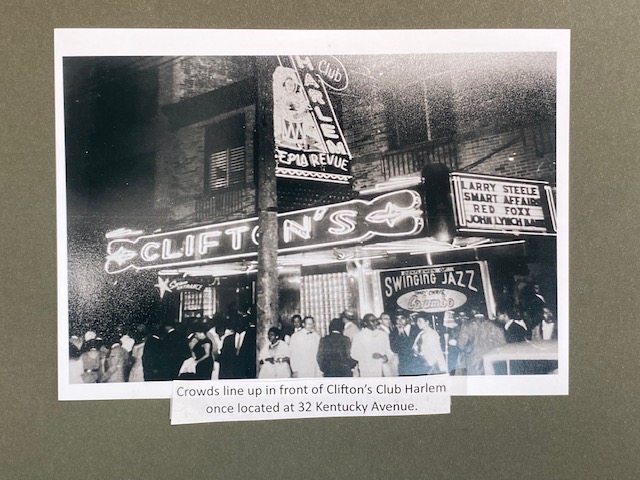
I wasn’t on a mission, but every time I wandered into the Atlantic City area, I would drift off the boardwalk and started exploring different Historical Society’s, and African American owned gallery’s and bumped into a number of old timers along the boardwalk or in a casino. It seemed like everyone I talked to over a long period of time all confirmed the Kentucky Avenue club scene, but really didn’t have many details for me.
I heard Kentucky Avenue was an African American community and they had several clubs over a two or three block strip, I’d always ask, “well exactly where were the clubs,” in hopes of visiting them and perhaps interviewing a few people there. The answers I got varied from oh, their just a few blocks off the boardwalk, to I’m not sure the clubs are there anymore, too, no, they were all sold off, and “I think there’s a bunch of parking lots there now” and so-on.
I’d also ask about the supposed “big time performers that played these clubs” and heard different names like Louis Armstrong, Jackie Wilson, Sam Cooke, Cab Calloway, Sammy Davis Jr., Marvin Gaye and Billlie Holiday. These performers were heavy hitters in the music industry, all at the height of their careers, and different people were telling me that they all played in various clubs along Kentucky Avenue.

So, like I said, I wasn’t on a mission, I was just inquiring now and then, about this Kentucky Avenue scene for a number of years. So, I decided to get serious about the history of this avenue and these clubs and the performers that played in these clubs. I took the time to visit a number of historical society’s and other history outlets, I succeeded in getting only tid-bits of information, to the point I knew this place existed, a lot of what would be considered superstars today actually performed along the strip and that most all of the buildings where the clubs once existed were all demolished, and that was about it. No-where could I find photographs of Kentucky Avenue in its hey-day or photographs of the clubs where these entertainers performed. I actually walked North Kentucky Avenue where the buildings once stood and confirmed some good looking parking lots where the buildings were once located.
Keep in mind, I’m an outsider and not familiar with the local history scene in Atlantic City so I’m sure there’s a few places I was un-aware of for gathering information. So, I recently visited Atlantic City and I wandered into the Princeton Antiques and Books Store at 2917 Atlantic Avenue, and found a treasure trove of information and photographs.
If you’re looking for information or photographs from Atlantic City’s past, they have dozens of books with information and photographs along with thousands of rare books. I talked to the owner Rob Rufo, (when I met with him, I dubbed him “Big Rob” in my mind,) we chatted for about a half hour or so and he turned me onto some of Atlantic City’s Black History that included the Kentucky Avenue story along with a few rare photographs.
While I certainly don’t consider myself an expert on Kentucky Avenue, nor will I pretend to even know a lot about it, here’s the information I came up with thanks to the help of Princeton Antiques & Books, and “Big Rob,” and a few other sources including the Atlantic City Library. If you enjoy a good music story, along with a little black history, here’s the story of Kentucky Avenue.

Kentucky Avenue, Atlantic City
Dozens of African American family owned retail businesses along Kentucky Avenue from Atlantic Avenue to Artic Avenue, and all along Artic Avenue in Atlantic city’s northside thrived for many years.
Artic and Kentucky Avenues were considered a “Main Street” like many others you might find in any small town in America, except these Main Streets in Atlantic City were owned and operated primarily by African Americans. Many of the store and shop owners lived above the businesses.
These residents had developed their own city within a city as a way of making a living and a way of supporting other black owned businesses. As one writer stated, “They had all the ingredients of a societal infrastructure up and running on their own.”
Atlantic City’s Kentucky Avenue was like many other Main Streets in America, kind-of like a city within a city, If you think Fayette Street in Conshohocken in the 1940’s and 1950’s, Main Street in Manayunk, Main Street in Norristown during its heyday, or Bridge Street in Phoenixville, it kinda gives you a snapshot of what Kentucky Avenue in Atlantic City once was.
Kentucky Avenue was a thriving retail and service corridor set in a well-established black community. Just three blocks off the world famous Atlantic City Boardwalk. Businesses during the 1950’s and early 1960’s along Kentucky Avenue included John Anderson’s Shoe Repair Shop, Hatcher’s One Hour Dry Cleaning, Kensington Carpet Company, People’s Smoke Shop, Ike’s Record Shop, Grace Daniels Beauty Shop, the Golden Cocktail Bar, Little New York Barber Shop, Grace’s Barber Shop, Harlem’s Coffee Shop, Bacharach’s Billiards, Johnson’s Hotel, Jerry’s Barbeque, Micky’s Shoe Repair, Wash’s Restaurant, Brody’s Pool Room, Sonny’s Barber Shop and Pool Room, Booker The Bone Cooker, Sapp’s Restaurant and for many years there was London’s Drug Store at the corner of Kentucky and Artic Avenues.
Having Black owned businesses in Black owned neighborhoods wasn’t uncommon particularly in the middle part of last century. Many historians might remember these neighborhoods and shopping districts in other parts of the country. There was Tulsa, Oklahoma, back in the early part of the century, the Greenwood District had a section known as “Black Wall Street” that was burned to the ground in 1921 when race riots leveled 35 square blocks of the neighborhood. The Hayti District in Durham, North Carolina was known as “The Black Capital of the South,” of course most of us know about Harlem, in New York known by many as the “Black Mecca.”
A very popular Black neighborhood on U Street in Washington D. C. back in the day was known as “Black Broadway.” A similar district in Dallas, Texas was Tenth Street, as was The Fourth Avenue District in Birmingham, Alabama. Jackson Ward in Richmond, Virginia was known as “Harlem of the South.” John Wesley Hobbs, a writer, referred to Sweet Auburn Historic District in Atlantic Georgia as the “Richest Negro Street in the World,” due to the many black owned businesses.
This list of successful black owned main streets throughout the country were many, Kentucky Avenue in Atlantic City being one of them. However, no black owned or populated community in the country had what Kentucky Avenue had, the amount of music entertainment, and the volume of national and international stars that once graced the stages of the nightclubs along the strip.
There was Club Harlem, perhaps the best known club once located at 32 Kentucky Avenue, Club Harlem had two lounges and a main showroom with seating for about 1,000, and a cocktail lounge with room for another 400 guests. The club had seven bar’s; the front bar alone accommodated nearly 100 guests. It was said that weekends at Club Harlem in the summertime started on Friday night, with two bands on different stages performing alternating sets, the music continued nonstop until Monday morning.
Other clubs along the strip included Little Belmont, (or Grace’s Little Belmont), a little Jazz club located at 37 Kentucky Avenue across the street from Club Harlem. Gracie’s Little Belmont was once owned by Herman Daniels and his wife, Grace from the mid 1930’s through the 1970’s. Sammy Davis Jr., a childhood star would often perform at Club Harlem and his mother Eliera “Baby Sanchez” Davis, would often spend her summers in Atlantic City and worked as a barmaid inside the horseshoe shaped bar at Little Belmont.
As told in an article written by Ray Schwiebert, “Long before legalized gambling hit Atlantic City most all of the clubs had some type of gambling going on. In between Gracie’s and an establishment called Jerry’s Barbecue was an alley where a popular games of chance took place.”
“People would play a game called the “Skin Game,” it wasn’t legal but as long as people behaved themselves, the police, pretty much looked the other way.”
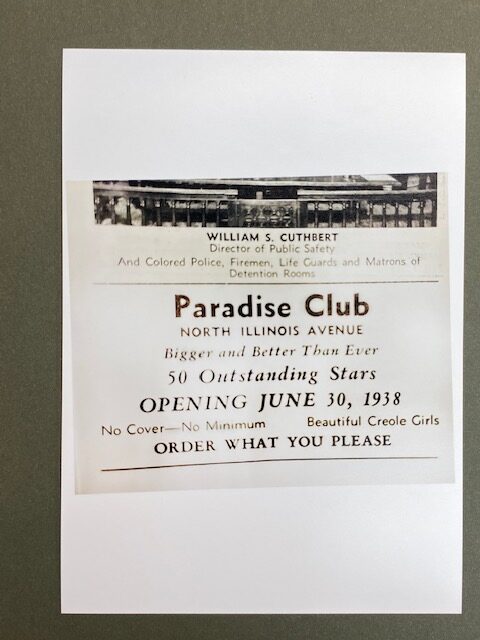
The Paradise Club or Club Paradise was a nightclub and jazz club once located at 220 North Illinois Avenue, (Illinois Avenue no longer exists, it was renamed Martin Luther King Blvd in 1988). Illinois Avenue is located two blocks off Kentucky Avenue where the Paradise Club and other clubs were located. It was known for its raucous floor shows featuring gyrating black dancers accompanied by high energy jazz bands led by the likes of Count Bassie and Lucky Millinder.
The club opened in the 1920’s and was owned by Harold Paul Abrams, who also owned Harold’s Club and the Basin Street Club, at that time located just around the corner from Kentucky Avenue at 5 North Illinois Avenue.
Abrams was also general manager of the 500 Club. Abrams promoted the Paradise as “The oldest nightclub in America,” It was the first club to offer “Breakfast Shows” after the nightlong entertainment.
“The club’s nondescript exterior and “simple neon sign” revealed nothing of the raucous goings-on within. The interior was designed like “a prohibition-era roadhouse” with darkened rooms, low ceilings, and small tables arranged around the dance floor and stage. During the stage shows, while amber, and blue colored spotlights played around the room. A girl in a short skirt walked around the room taking souvenir pictures of the guest.” (paragraph taken from Wikipedia, Paradise Club)
“The Paradise Club was one of four Atlantic City nightclubs raided by police in July 1940, on suspicion of illegal gambling activities. Led by the new mayor Tom Taggert, the raiding party confiscated “three truckloads of gambling paraphernalia” and arrested 32, then shut down the Paradise Club. Club Harlem, the Wonder Gardens, and Gracie’s Little Belmont. The clubs were doing business as usual the day after the raid.
As Mayor Taggart began the action he called 40 policeman into his office, strapping in a revolver and stating, “Come on, we’re going places.” (info also taken from Wikipedia, Paradise Club)
In 1954, Club Paradise merged with Club Harlem under joint ownership.
Also located on Illinois Avenue was a little less known club called the Clicquot Club. It was billed as the club that “never closed” once located at 15 North Illinois Avenue and became notorious as an illegal gambling spot in the city.
The Clicquot Club operated during the Prohibition era in the 1920’s, the club provided both illegal liquor and illegal gambling. While there was a bar and cabaret in the front rooms there was profit making roulette wheels, crap tables, and card games in the backrooms.
In December of 1931 a raid was conducted at the club in which Federal Agents removed $20,000 worth of lavish Japanese and Chinese furnishings from the 20 room mansion and “poured several thousand dollars’ worth of alleged whiskies and champagnes down a drain.
The bar and cabaret also developed a reputation for lawlessness as the Clicquot became known as one of the “bust-out joints” for Philadelphia convention-goers eager to “release their inhibitions as they experienced everything and anything available.” (information also taken from Wikipedia, Clicquot Club)
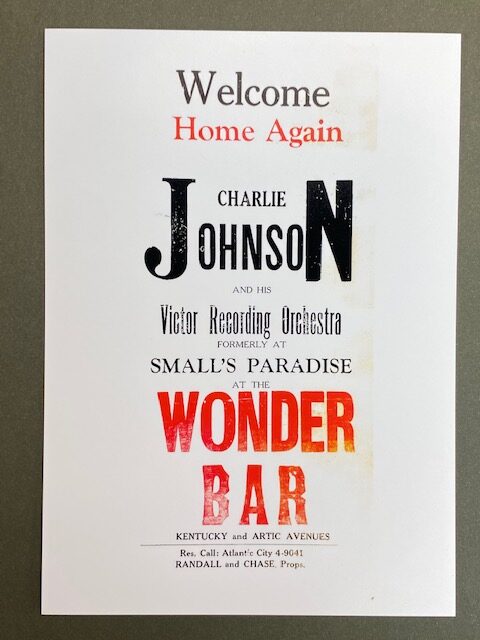
At the corner of Kentucky and Arctic Avenues at 1601 Arctic Avenue was the Wonder Gardens also known at the Wonder Bar. The Wonder Gardens was establishedin 1929, it wasone of four black-owned nightclubs in the black entertainment district on Kentucky Avenue. Between the Wonder Gardens, Club Harlem, the Paradise Club, and Grace’s Little Belmont, the music played all night and into the morning in the district’s heyday in the 1940’s through the late 1960’s.
Over the years the music changed from jazz to rock, soul, and pop music. In 1979, the club was renovated, redecorated and renamed the Latin Wonder Gardens, featuring live Afro-Cuban musical entertainment. In 1991 it underwent a second renovation and name change to the New Wonder Gardens, featuring Latin, Jazz, R&B, Hip-hop, and reggae acts. The club was sold in 2001 and later demolished.
Just a few minutes down Atlantic Avenue, from Kentucky Avenue, was Missouri Avenue where the former 500 Café, later renamed the 500 Club was located. The nightclub and supper club was purchased in 1942 by racketeer Paul “Skinny” D’Amato, the club operated from the 1930’s until the building burned down in 1973.
“The main bar was large and black, with black and white zebra-patterned wallpaper on the walls of the room. An indoor waterfall surrounded by imitation exotic vegetation stood in the back. The club’s main showroom, the Vermilion Room, often featured the likes of Frank Sinatra, Sammy Davis Jr., and the slapstick comedy duo of Dean Martin and Jerry Lewis.” (Wikipedia—500 Club)
The 500 Club was patronized by both whites ad African Americans. Mobsters and politicians were frequent patrons with the former, “making deals” with the latter, these guests were never presented with a bill. Joe DiMaggio, had his own table and his own waitress to serve him free drinks.
Of course, like many of the other nightclubs of the day there was illegal gaming going on in the backroom like roulette wheels, craps tables, baccarat and high-stakes card games. The door to the back rooms were beyond the main showroom and was guarded by a doorman, it opened on D’Amato’s nod or word. D’Amato shut down the illegal casino in the early 1950’s in wake of pressure on organized crime exerted by the Kefauver Committee in the United States Senate and expanded the supper club aspect. In 1955 the club expanded its show seating capacity to 700.
Other acts that appeared at the 500 Club over the years included Jimmy Durante, Eartha Kitt, Patti Page, Milton Berle, Nat King Cole, Liberace and Sophie Tucker who had a very interesting career. Sophie tucker was known as “The Last of The Red-Hot Mama’s.” She performed for King’s and Queen’s in England, was a theatre and radio star with many popular recordings. She is credited with influencing many female entertainers over the years including Mae West, Carol Channing, Totie Fields, Joan Rivers, Roseanne Barr, Ethel Merman, “Mama” Cass Elliot and Bette Midler just to name a few.
Frank Sintra called on his friendship with D’Amato to perform at the club in the 1940’s when his career was at a lull. He regularly performed there from the 1940’s through the 1960’s. During Sinatra’s engagements at the club in the 1950’s the 500 marquee read simply, “He’s Back.”
The club was destroyed in an electrical fire that burned for four hours in June of 1973, with more than 200 firemen fighting the fire.
(The 500 Club is mentioned frequently in the A&E Documentary File on “The Rat Pack,” I think from 2002)
The performers
There is no-way to compile a complete list of performers who entertained the masses along the Kentucky Avenue corridor over the years, but I put together a partial list of some of the more popular, and a few names you might not be familiar with but trust me when I say this, every performer who stepped on stage was a star in their own right.
Ella Fitzgerald, Aretha Franklin, Redd Foxx, Marvin Gaye, Dizzy Gillespie, Dick Gregory, Frank Sinatra, The Stylistics, The Temptations, Sarah Vaughan, Freda Payne, Dionne Warwick, Harry Belafonte, Count Basie, Milton Berle, James Brown, Lenny Bruce, Cab Calloway, and Dinah Washington.
There was Lester Young, a saxophonist with the Count Basie Orchestra. Young played for Billie Holiday in studio sessions for years and recorded with Nat “King” Cole, and also toured with Miles Davis.
Hershal Evans, a Tenor Saxophonist who played in the Count Basie Band, he also played with Lionel Hampton and the Harry James Orchestra. Lucky Thompson, a Tenor-soprano Saxophonist
Who played with Miles Davis, the Count Basie Band and Charlie Parker. Ernestine Anderson, a vocalist who toured with Lionel Hampton and was a Grammy award nomination Jazz singer. Lovelace Watkins, another smooth singing performer who was nicknamed “The Black Sinatra” appeared on many television shows over the years including the Ed Sullivan Show, Johnny Carson Show and the Mike Douglas Show.
Texas born T-Bone Walker played the Atlantic City clubs on the North Side, Walker was named Rolling Stone’s #67th greatest guitarist of all time, was inducted into the ”Blues Hall of Fame” in 1980, and into the ”Rock and Roll Hall of Fame” in 1987.
Damita Joe DeBlanc, a prominent singer and actress in her day is credited with two Answer Songs that hit the Top 100 Charts in the early 1960’s. An ANSWER SONG was common in the 1960’s, when one performer would put out a record and another performer would answer. (When Neil Sedaka had a hit with “Oh Carol,” referring to Carol King, Carol King responded with a minor hit called “Oh Neil”)
Well, Damita Jo, who played Kentucky Avenue on many occasions recorded “I’ll Save The Last Dance For You” as a response to, “Save The Last Dance For Me” and she also recorded an answer song called “I’ll Be There,” an answer song for “Stand By Me.” Both songs were originally sung by Ben E. King. Damita Jo also worked with Ray Charles, Count Basie and Lionel Hampton. She was also involved with comedy for a time and toured with Redd Foxx.
Regulars along the Kentucky Avenue corridors also included Billie Holiday, George Kirby, Gladys Knight, Jackie “Moms” Mabley, Charlie Parker, Billy Paul, Teddy Pendegrass, Louis Armstrong, Wild Bill Davis, Boyz ll Men, Florence Ballard of the Supremes, Leslie Uggams, Ethel Waters, Lou Rawls, Nipsey Russell, Ray Charles, Nat King Cole, Crazy Chris Columbo and his Orchestra, Sam Cooke, Bill “BoJangles” Roberson, Harry Belafonte, Jerry Butler, The Commodores, The Delfonics, Kool and the Gang, Harold Melvin and the Blue Notes, Johnny Nash, (I Can See Clearly Now), Russell Tompkins Jr., Sister Sledge, Jackie Wilson, Duke Ellington, and Sammy Davis Jr., who would often invite white members of the RAT PACK to join him on-stage.
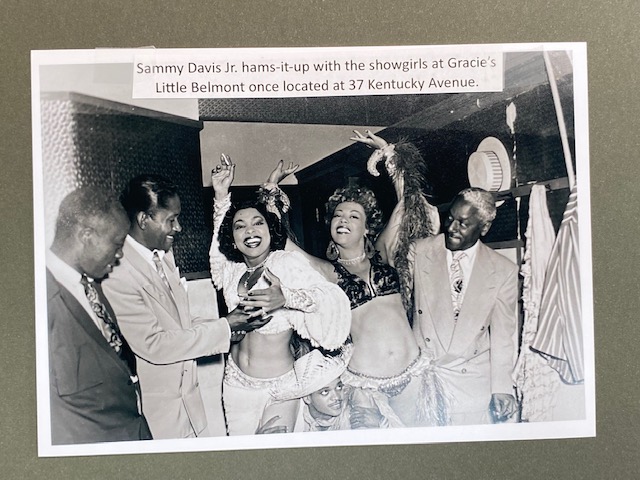
Sallie Blair was a jazz singer and performed over the years with the likes of Duke Ellington and Cab Caloway’s Cotton Club Revue. Because of her voluptuous figure and blond hair Miles Davis called her the “Brown Marilyn Monroe.” Sallie appeared in various publications back in the day including Life Magazine, Esquire and Jet. She appeared on the Ed Sullivan Show, Late Night with Johnny Carson Show, the Danny Kaye Show and the Rosey Grier Show. (We don’t need to mention how rare it was back then for a black performer to be featured on any show.)
Tyrone Davis was more of a Blues and Soul singer with a long list of hit records throughout the years. He had three Number One hits with “Can I change My Mind,” “Turn Back The Hands Of Time,” and “Turning Point.” He also had a Disco hit with “Get On Up” which reached number 12 on the charts.
A name that kept showing up in the Kentucky Avenue Club scene was Billy Eckstine, (a name I was unfamiliar with). Eckstine is a Grammy winner and was presented with a Lifetime Achievement Grammy Award and is in the Grammy Hall of Fame. He was born in Pittsburgh Pa., and is credited with a number of Gold Records. Eckstine appeared in films and performed on every television show throughout the years including Merv Griffin, Art Linkletter, Ed Sullivan, the Nat King Cole Show, the Tonight Show with Steve Allen, Jack Parr and Johnny Carson. He was also on the Joey Bishop Show, Dean Martin Show, Flip Wilson Show, and the ever popular “Playboy After Dark Show.”
Eckstine appeared on Stanford and Son sitcom show along with other shows of the day. He performed the Star Spangled Banner before Game four of the 1979 World Series at Three Rivers Stadium, his home town.
The Emotions vocal group showed up along Kentucky Avenue over the years. They were a popular smooth sounding soul group who was named by VH1 as one of the 18 most influential girl groups of all time who also won a number of Grammy Awards and was awarded with Gold and Platinum records over the years. Betty Wright was yet another example of the Kentucky Avenue Star Power having made a number of stops along the strip. Betty released her first Number One hit when she was just 17 years old, her song “Clean Up Woman” was on the billboard charts for fourteen weeks.
Ethel Waters was a ground breaking show-biz African American female who was born in Chester Pennsylvania. She worked the nightclub circuit for many years including Atlantic City’s Kentucky and Artic Avenues. She was the second African American to be nominated for an Academy Award and the first African American woman to be nominated for a Prime-Time Emmy Award.
In 1939, Ethel the first African American to star in her own Television Show, “The Ethel Waters Show.” She was later nominated for an Academy Award for Best Supporting Actress for the film, “Pinky” in 1949.
My, My, the list of “A” performers of the Kentucky Avenue era goes on-and-on, maybe just a few more. There was Lena Horn, a singer, actress, dancer and Civil Rights Activist. Lena appeared in film, television and theatre. She was an extraordinary woman. Think about this! Lena participated in the March on Washington in 1963 With Dr. Martin Luther King, she worked with First Lady Eleanor Roosevelt in an attempt to pass anti-lynching laws throughout the United States, she was at the White House to visit with then President John F. Kennedy demanding equal rights for African American citizens, her visit with Kennedy happened on November 21, 1963, just two days before the president was assassinated in Dallas.
Chuck Jackson was a Rhythm and Blues singer who loved performing on Kentucky Avenue. Jackson is best known for his 1960 “Any Day Now”, another hit in 1961 was “I Don’t Want to Cry” and another one of his more than dozen billboard hits included “Tell Him I’m Not Home” released in 1962.
Bootsie Barnes was born in the North Philadelphia projects and became a Jazz Tenor Saxophonist who recorded a number of albums over the years including “You Leave Me Breathless” in 1995. Bootsie traveled the world playing but according to Bootsie he loved the New Jersey Clubs, and named the Dreamland, Cotton Club, Loretta’s High Hat Club, and Club Harlem. Bootsie died in April of 2020 at his home in Wynnewood Pa. of covid.
Millie Jackson was another vocalist who had a natural talent for rhythm and Blues who recorded with success throughout her career with more than 30 album’s to her credit. In 2012, a documentary was released and aired on television called, “Unsung—The Story of Mildred “Millie” Jackson.”
Certainly, most of us know or are aware of Stephanie Mills who entertained the masses along Kentucky Avenue back in the day. Stephanie rose to stardom as “Dorothy” in the original seven-time Tony Award winning Broadway run of the musical “The Wiz,” which ran on Broadway from 1974 until 1979. During the 1980’s Stephanie had five Number One hits on the R&B charts.
Hot “Lips” Page was a Trumpeter and Band Leader in demand throughout the country who had worked with Bessie Smith, Count Basie and opened the famous “Birdland” jazz club with Charlie Parker in New York in 1949. Roy Hamilton shot to stardom in 1955 when he sang “You’ll Never Walk Alone” on the Ed Sullivan Show and had many hits to follow.
Barbara McNair was a regular at Club Harlem for a time, she found success with her first hit, “Till there Was You” in 1958 and went on to star in television, stage and films. She played Sidney Portier’s wife in the movie “They Call Me Mr. Tibbs,” and the sequel “The Organization.” Barbara also found time to tour the world with Nat King Cole.
Lola Falana was a beauty born in Camden New Jersey and raised in Philadelphia, Pa. Sammy Davis Jr. was credited with discovering Lola and sending her on her way to stardom. She performed at a number of the Kentucky and Artic Avenue clubs before heading for show-business in a big way. Lola was nominated for a Golden Globes and Tony Awards during the course of her career. She became the highest-paid entertainer in Las Vegas, that earned her the title, “First Lady of Las Vegas.”
We can’t leave without pointing out Slappy White, the Atlantic City comedian who not only worked the Atlantic City Club Scene but also worked the Chitlin Circuit with Redd Foxx for years.
Slappy would later make appearances on the television shows “Sanford and Son,” “That’s My Mama,” “Blossom” and “Cybill.” He also appeared in a number of movies including “Mr. Saturday Night.” Slappy was married to LaVern Baker for about a decade, LaVern had many hit songs of her own.
Space and time doesn’t allow me to print all the vocalist, great band members and other performers who walked the streets of Atlantic City and performed on their many stages over the years but I think it’s safe to say that there were many and they were all great in their own right.

What Happened to Kentucky Avenue?
Well, all the experts have weighed in, the Atlantic City leaders from over the years have given us their view of what happened to the vibrant life that once graced the avenue, we’ve heard from the residents, the city and the state of New Jersey about what happened to Kentucky Avenue. Lets throw in the club owners, the landlords and the land-owners, everyone has an opinion about why and how the avenue shut-down.
Residents and city officials pointed to the assassination of the Black Mafia’s “Fat” Tyrone Palmer that took place on Easter morning in 1972 at Club Harlem, as the beginning of the end for Kentucky Avenue’s club scene.
The assassination occurred in full view of a show audience estimated at about 600 people. Three young women and a millionaire heroin pusher were killed in what police said was a wild nightclub shootout by gunmen from a rival Philadelphia narcotics ring. In the end four people were killed and another 26 injured in the shootout.
Four rival operatives entered the club and one shot Palmer in the face in full view of the audience just as the featured singer Billy Paul finished his opening number. Following the shootout, Club Harlem went into a steep decline throughout the rest of the decade.
Club Harlem was last opened for business in the summer of 1986 before shuttering its doors. It was the last of the Atlantic City’s major golden age nightclubs still in operation. In December of 1992 a nor’easter struck the building and the building was torn down.
The demise of the other major night clubs.
The 500 Club—had an electrical fire in 1973 causing more than $1.5 million in damages,
It never reopened.
The Dreamland Café— slid into a decline throughout the 1960’s, The world-class talent and entertainment headed to the mainstream theater’s in Cherry Hill, Philadelphia and Atlantic City. The Dreamland Café was demolished in the summer of 1995.
Wonder Gardens—The club was renovated in 1979 and renamed the Latin Wonder Gardens. In 1991, it underwent a second renovation and named change to the New Wonder Gardens, The club was sold in 2001 and later demolished.
The Paradise Club—merged with Club Harlem in 1954—Like many other nightclubs in the district, the Paradise Club succumbed to a drop-off in business from the advent of legalized casino gambling in Atlantic City. By the mid 1980’s only Club Harlem was still operating. The site is now a parking lot.
Some claim the casino’s finally forced Club Harlem to close as the top tier talent played to larger crowds on bigger stages in the casino’s while others still point to the 1972 Easter morning assassination of the Black Mafia’s “Fat” Tyrone Palmer in full view of a show audience.
Club Harlem—it was last opened for business in the summer of 1986 before shuttering its doors. It was the last of the Atlantic City’s major golden age nightclubs still in operation. In December of 1992 a nor’easter struck the building and the building was torn down.
From an outsiders view, (me) who has witnessed his own community go through revitalization, I watched the bull-dozers level old buildings, historic buildings, and boarded-up eye-sores.
I never saw one show, one night club or one business along Kentucky Avenue during it’s heyday, I offer you this.
Kentucky Avenue is, and simply was a victim of the times, America was changing, Main Street USA was changing, Atlantic City was starving by the 1960’s, Philadelphians headed south to Sea Isle, Wildwood, Cape May, with the advent of places like Las Vegas and Disneyland, Atlantic City was no longer “America’s Playground,” the hotels were old and worn, the boardwalk and beach struggled to keep up with the maintenance, beach-goers were forced to park blocks away from the water. Atlantic City had become outdated and tired looking.
The statement and question addressed many times was, “Did the casino’s muscle-out Kentucky Avenue?” That statement and question will remain open for debate as long as “The Golden Era of Kentucky Avenue” is discussed.
The Kentucky Avenue buildings were old, the rents became unaffordable as shoppers rushed to the box stores to save a buck. Most small business owners will be quick to point out that shopping small and local helps the community, and it does.
With today’s society, residents of the neighborhood have become part-time residents, or short term residents, or residents who simply don’t care about the neighborhood they live in.
Shoppers today don’t want to ride around the block four or five times before finding a broken meter to put their quarter in for the privilege of parking for ten minutes for every quarter.
And finally, in the end, maybe the casino’s did win-out. Mention Atlantic City today, people think casino’s! The average visitor coming out of Philadelphia or elsewhere aren’t thinking, “Atlantic City, let’s visit the beaches, take a walk off the boardwalk and visit a restaurant two or three blocks away, or supporting small family businesses.
I’m an outsider and a lot of readers and residents will be quick, (and rightly-so) to say “What does he know?” and you’re right, but I’m entitled to my opinion, and my opinion is this! When the casino’s negotiated gambling rights in New Jersey in the mid 1970’s they promised the city everything and anything, a good portion of the promises missed the mark. Atlantic City’s streets should be paved in gold, not just for a block or two, off the boardwalk, but the entire town.
Atlantic City residents can be thankful for everything the casinos have done, but is it enough.
When I was walking the streets of Kentucky and Artic Avenues, trying to image the small businesses and nightclubs that once called the avenues home, the street felt cold, there were no buildings, no residents or other people walking about, a car pulled over to the side of the road and asked me if I was OK, or lost or looking for something that she could help me with?
That small gesture brightened my outlook on the area. I asked her a question or two about Kentucky Avenue, Club Harlem and the corner I was standing on.
Her name was LaToya Dunston and I explained to her that I was researching a little bit of the Kentucky Avenue history and nightclub life for an article I was about to write. She pointed me to where club Harlem used to stand, just a parking lot with a fence around it.
She seemed interested in the finished article so we exchanged business cards so she couldsee the finished product. I noticed later that she is a Second Ward Council Member forAtlantic City, and I thought it was rather nice, and considerate that she stopped to see if she could be of any assistance.
And THAT my friend, is what makes Atlantic City Great, it’s not the buildings or what used to be, or the fact that “America’s Playground” is no-longer “America’s Playground,” it’s the people. It’s the people like LaToya, she didn’t pull-up and say “Hey, “I’m a city Council-woman, you looking for something, she pulled over as a resident of Atlantic City to possibly render help and that’s the Atlantic City I’ll always remember.
Some people believe that Atlantic City can still turn-it-around, I believe that Atlantic City is already there, you just need to wander off the boardwalk, take in a few sites, check out the shopping district that welcomes you to Atlantic City, stroll the avenues and support a small family business or two and try having a lunch outside the casino’s.
I’ve certainly enjoyed my stroll up and down Kentucky Avenue, I think of the performers who sharpened their skills in the districts nightclubs before heading out to show the rest of the world what they accomplished in Atlantic City.
I stated in the beginning of this article that I didn’t know anything about Atlantic City’s Kentucky Avenue’s club scene and the artists who found comfort in performing there, now I know. I feel like I touched the ghost of Kentucky Avenue, it was a time we can never go back to.
Sources:
“The Northside” Book by Nelson Johnson
“Princeton Antiques & Books” Rob Rufo
2917 Atlantic Avenue NJ 08401
1-800-BK-FOUND
The Atlantic City Experience
The Press of Atlantic City
Wikipedia
Atlantic City Free Public Library
Thanks to Jackie Silver-Morillo


